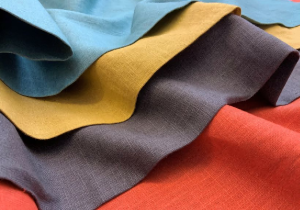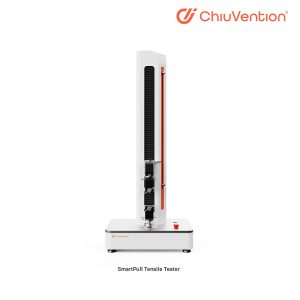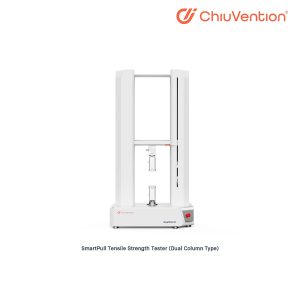1 Domestic and international standards for the determination of bursting strength of textiles
When a certain area of textile is fixed around it, and a vertical force is given from one side of the textile to make it broken, it is called top breaking or top cracking.
Textiles are often subjected to external forces in the warp, weft and diagonal directions at the same time when they are broken, especially some knitted fabrics have the characteristics of longitudinal extension and transverse contraction, which have a large influence on each other in the longitudinal and transverse directions. If the tensile strength test is used, the warp, weft and diagonal directions must be tested separately, while the top breaking test can be used to make a comprehensive evaluation of the textiles.
In addition, because of the rupture test, all directions are subjected to equal force, and there is no “necking” phenomenon, so this test is especially suitable for knitted fabrics, three-way fabrics, non-woven fabrics and parachute fabrics. China has taken the top-breaking strength as an index for assessing the inherent quality of some knitted fabrics. Many products in textiles at home and abroad, such as bedding (bed sheet, quilt cover, pillowcase), towels (face towel, bath towel, beach towel), kitchenware (tablecloth, apron, sleeve cover), sofas and so on, are required to carry out this test. There are two main methods for determining the breaking strength of textiles, i.e. the bullet breaking method and the elastic diaphragm expansion method. The relevant domestic and international testing standards for the determination of the breaking strength of textiles are shown in Table 3-13.
Table 3-13 Relevant domestic and international standards for testing the bursting strength of textiles
| Standard | Name of Standard | Note |
| GB/T 7742—2005 | Textiles-Determination of swelling strength and swelling expansion length-Elastic diaphragm method | Chinese National Standard |
| ISO 13981-1:1999 | Textiles-The swelling behaviour of fabrics -Part 1: Determination of swelling strength (hydraulic method) | ISO Standard |
| ISO 13981-2:1999 | Textiles-The swelling behaviour of fabrics -Part 2: Determination of swelling strength (air pressure method) | ISO Standard |
| ASTM D3786-87 | Test Method for Hydraulic Bursting Strength of Knitted Fabrics and Non-Woven Fabrics Diaphragm Type -Bursting Strength Tester Method | ASTM Standard |
| ASTM D3787-89 | Test Method for Knitted Fabric Bursting Strength -Constant Rate Draw (CRT) Ball Bursting Test | ASTM Standard |
| BS 4768-72(97) | Determination of fabric swelling strength and swelling degree of fabric | British National Standard |
| DIN 53861.1—1992 | Textile Tests-Top Break and Burst Tests-Definition of Terms | German National Standard |
| DIN 53861.2-1992 | Textile Tests-Top Break and Burst Tests-Test Methods | German National Standard |
| DIN 53861.3—1992 | Textile Tests-Puncture and bursting tests-Table of values for evaluation of test results | German National Standard |
| NF G07-112—1975 | Woven fabric test- Determination of bursting strength and elongation | French National Standard |
| KS K0350—1991 | Test Methods for Punching Strength of Fabrics-Ball Punching Method | Korean National Standard |
| KS K0351—1991 | Test Methods for Punching Strength of Fabrics-Punching Strength of Films | Korean National Standard |
2 Comparison of domestic and international textile bursting strength testing methods
Bullet breaking method
(1) Specimen preparation
Cut 5 round specimens with a diameter of 120mm at a distance of 150mm or more from the edge of the cloth. According to the regulations, the specimens will be sent to the constant temperature and humidity room for humidification treatment for testing.
(2) Instrument preparation
Check whether the components of the instrument are normal, and calibrate the strong pointer to zero.
SmartPull Tensile Tester is AC servo-driven and equipped with ball screws to provide stable pulling force and achieve higher testing accuracy. The software of the tester is compatible and powerful by outputting comprehensive test indexes, such as displacement, maximum force, elongation, stress, etc.; and there are various safety designs to protect the instrument and the operator’s safety. It is a tensile machine specially built for textiles, leather, footwear, etc. It can do tension, compression, bending, tearing, shearing, peeling and top-breaking tests. It is applicable to many international standards, such as ISO3377, ISO 13935, ISO 13937, ISO 20932-1, ISO 4674, ASTM 5034, ASTM D4964, GB/T 3917.5, FZ/T 01030 and so on.
(3) Clamping specimen
Put the wetted specimen into the clamping ring and screw it tightly, then put it flat on the cloth holder, pay attention to push the cloth holder to the bottom.
(4) Test
Activate the tester and push the activation spanner to restore the instrument to its original state after the specimen has been completely pushed through. Record the strength value indicated by the strength pointer on the dial, and take the average value of each test result as the breaking strength value of the sample.
The test shall be conducted in a standard atmosphere.
During the test, if the specimen is not clamped tightly, it will slip out of the ring, or the sample’s top breaking deformation is too large so that the specimen can not be broken. In this case, the test result is invalid and should be repeated with another specimen.
Elastic Diaphragm Expansion Method
(1) Specimen Preparation
Before the test, the laboratory sample is fully exposed to the specified test atmosphere for humidification, and then the specified size and number of specimens are cut from the sample. The specimens should be arranged in a trapezoidal shape on the sample and are required to be taken at least 1/10 of the width from the fabric edge.
The specimens are available in two sizes: 30.5 mm or 113 mm in diameter, depending on the equipment and requirements. Each sample should be tested at least 5 times in the regular test, and 10 times in the international trade arbitration test, with 2 additional pre-tests.
(2) Instrument preparation
Check whether the parts of the instrument are normal.
ChiuVetion’s HydroBurst Automatic Bursting Strength Tester utilizes hydraulic bursting (diaphragm method) to determine the bursting strength and expansion of knitted fabric, woven fabric, non-woven fabric, laminated fabric, elastic woven fabric, paper, and other materials when subjected to stress in both warp and weft directions, as well as in all other directions, to get the material’s resistance to bursting.
(3) Holding specimen
Cover the specimen on the diaphragm, flat and tension-free, and clamp the specimen firmly with the ring clamp. Be careful not to damage the specimen with the clamp when applying pressure.
(4) Measurement
① Pre-test: Before the test, clamp the 2 additional specimens prepared according to the regulations, and then start the instrument for pre-test to observe whether the strength of the fabric to the point of rupture is completed within the specified time limit. If not, adjust the pressurisation rate according to the conditions of the apparatus so that the average bursting time is within the specified range. (30±10)s for general fabrics and (15±10)s for woollen fabrics.
② Start test: On the basis of the pre-test, test the specimens one by one with the adjusted pressurisation rate and record the bursting strength and expansion of the specimens. If the specimen breaks at the edge of the fixture ring, another specimen should be taken and redone.
③ Test the diaphragm correction factor: with the same pressure rate as the above test, in the absence of specimens, clamp the diaphragm with the fixture, so that the diaphragm expansion of the above specimens reaches the average expansion degree of expansion of the pressure required, is the diaphragm correction factor.
(5) Calculation of results
Expansion strength is calculated according to the following formula:
A=B-C
A – the average expansion strength of the diaphragm top broken specimen, kN/m².
B – Measured fabric breaking strength, kN/m².
C – Diaphragm correction factor, kN/m².
3 Bursting Strength Test on Textiles
- Research on the improvement of knitted products’ bursting strength test method
(1) The main test parameters of domestic and international standards for the bursting strength test
The difference between the current Chinese test method and the international standard mainly lies in the size of the top-breaking device (see Table 3-14).
(2) Difference in test results between national and international standards
Top breaking strength is a durability index directly reflecting the deformation and rupture of knitted fabrics by external compression. China generally takes the top-breaking strength as an assessment index for imported and exported knitted products. At present, the test method adopted is only briefly stipulated in the knitted product standard GB/T 8878-2002 “Cotton Knitted Underwear”, the technical content is not complete enough, and there is a big difference between the technical content and the international standard ISO and other national standards ASTM, BS, EN, JIS, and the test results are generally lower than those according to the international standard, which is not only unfavourable to the export of products but also unfavourable to the export of products. This is not only unfavourable to the export of products, but also unfavourable to the quality control of imported products.
Table 3-14 Main test parameters of domestic and foreign standard bursting strength test
| Standard No. | Scope of use | Diameter of top pressure ball/mm | Fixture inner diameter/mm | Top pressure rate/(mm/min) | Number of specimens |
| No.1 | Coated fabrics | 25.4
|
45
|
300
|
5
|
| No.2 | Coated fabrics | 38 | 45 | 300 | 6 |
| No.3 | Coated fabrics | 25.2 | 45 | 300 | 5 |
| No.4 | High elongation knitted fabrics | 25.4 | 44.5 | 305 | 10 |
| No.5 | knitted fabric | 25 | 44 | 100 | 5 |
| No.6 | Cotton knitwear | 20 | 25 | 100 | 5 |
Notes*
No. 1, ISO 3303-1990 “Rubber- or plastics-coated fabrics-Determination of bursting strength”.
No. 2, EN 12332.1-1998 “Rubber- or plastics-coated fabrics-Determination of bursting strength Part 1: Steel ball method”.
No. 3, BS 3424-6 “Testing coated fabrics-Part 6:Method 8B.Hydraulic method for determination of bursting strength”.
No.4, ASTM D3787-2001 “Method for the determination of breaking strength of knitted fabrics”.
No. 5, JIS L1018-1999 “Test Method for Knitted Fabrics”.
No. 6, GB/T8878-2002 “Cotton Knitted Underwear”, Clause 5.4.1.
(3) Improvement method
The CRE isotropic elongation type material testing machine is adopted, with the diameter of the top ball φ25mm, the inner diameter of the clamp φ45mm, the effective range of the top breaking combination device 120mm, and the top pressing rate of 300mm/min. The above data is used as the process parameter of knitted fabrics top breaking strength test, which is in line with the international standard, reasonable and operable, and can effectively solve the problem of low test results and top breaking test of knitted fabrics made of new materials with high elasticity and high strength.
- Uncertainty analysis of knitted fabric bursting strength test
According to the characteristics of the commodity, the test method and the actual operation, the sources of uncertainty of the top breaking strength test of knitted fabrics are the uncertainty caused by the randomness of sampling, the difference in the operation of the testing process and other components; the accuracy of the material testing machine, the sensitivity of the instrument to tracking the stress and the accuracy of the modulus conversion (including the digital modification), which leads to the error of the display value of the automatic display terminal. Zhang Zhuo, in accordance with GB/T 19976-2005 “Textiles-Determination of bursting strength-Steel ball method”, the operation method of the steel ball method, using INSTRON 4465 universal material testing machine (CRE), the top breaking strength of knitted fabrics test uncertainty of experimental evaluation and analysis, that the main sources of uncertainty are the randomness of the sampling, the strength of the machine’s accuracy, etc., so in order to ensure the correctness of the test results, the accuracy of the instrument tracking stress and modulus conversion (including digital modification) leads to the error in the value of the automatic display terminal. The main sources of uncertainty were found to be the randomness of sampling, the accuracy of the indicative value of the tester, etc. Therefore, in order to ensure the correctness of the test results, it is necessary to ensure the accuracy of the traceability of the instrument and to carry out the planned periodical verification.
For measuring bursting strength test by steel ball method, SmartPull Tensile Strength Tester (Dual Column Type) would be a good choice.
SmartPull Tensile Strength Tester features as follows:
- AC servo drive + ball screw, with force accuracy within 1%, ensuring the reliability and repeatability of test results.
- 100 kg lighter than the initial generation, making it easier to handle and operate.
- Intelligent and active displacement and torque alarm systems, overload and emergency stop devices, and up-and-down travel limiting devices, always keep the testing process safe and stable.
- Optional S-type load cell with automatic identification function for pulling force of 5KN-10KN-20KN to realize more testing function.
- Test software can be applied to different languages, and get more comprehensive test indicators, including displacement, maximum force, elongation, bending stress, speed and other test results.
- Influencing factors of bursting strength knitted products by Steel ball test method
(1) Relationship between the running rate of the top bar and the bursting strength
The bursting process of knitted fabrics is a tensile bursting process. Since knitted fabrics are interlocked mesh structures, the external force is not concentrated at a certain point or on a certain yarn but is transmitted unevenly in all directions. When tensile deformation occurs, the force on the fabric at the top of the bullet crown gradually becomes smaller and smaller, while the force on the edges continues to build up as it is difficult for the force to dissipate outwards, eventually leading to rupture. When the running speed of the top bar is within a certain range, the fabric is subjected to a constant force applied by the top bar, which is similar to the deformation of a spring under pressure, and the rate of application of the force does not change the magnitude of the force on the receiving body. The rate of force application does not change the magnitude of the force on the receiving body. Therefore, the rate of operation of the top bar does not have a significant effect on the breaking strength of the fabric.
(2) Relationship between bullet diameter and bursting strength
At the same running rate as the top bar, as the diameter of the slug increases, the breaking strength also increases. This is because as the diameter of the bullet increases, the area of the specimen subjected to the top force also increases, and the number of force line turns increases, which inevitably leads to an increase in the top breaking force. However, there is a certain correlation between the top breaking force measured with different diameter slugs.
(3) The relationship between different test methods and bursting strength
GB/T 8878-2002 “Cotton knitted underwear” in the 5.4.1 article of the test method and GB/T19976-2005 “Textiles-Determination of bursting strength-Steel ball method,” the main difference lies in the top bar running rate and the diameter of the bullet. GB/T 8878-2002 stipulates that the running speed of the top bar is 100mm/min and the diameter of the slug is 20mm; in GB/T 19976-2005, the running speed of the top bar is changed to 300mm/min and the diameter of the slug is changed to 38mm or 25mm. (However, the diameter of the slug is specified to be 38mm in knitted products which refers to the standard as the test method.
The result of GB/T 19976-2005 is greater than the result of GB/T 8878-2002 5.4.1, and there is a good linear relationship between the two methods.
If you want to learn more professional textile-related knowledge, please bookmark our website. Chiuvention will be your knowledge base for textile calculations, textile testing methods, and instrument operating.



